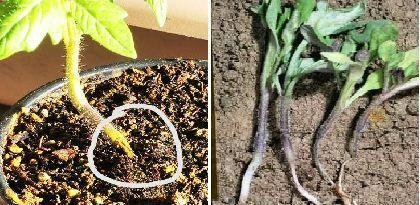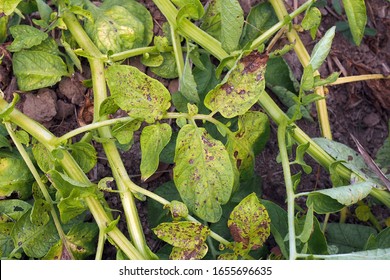Early blight of potato and tomato
- Early blight of potato causal organism: Alternaria solani.
- Early blight of tomato causal organism: Alternaria solani.
Symptoms of early blight of potato/tomato
Major symptoms of early blight of potato/tomato are found in seedling, leaf, stem, and fruits.
Symptoms on seedling:

- Damping-off at the seedling stage of tomato, stem lesions occur, and collar rot is found.
Symptoms on leaf:

- Initially, small dark spots form on older foliage near the ground.
- Leaf spots dark brown to black with the concentric ring. Yellowish, dryer, drop, or fall off.
- Severely infected leaves turn brown and fall off or dead; dried leaves may cling to the stem.
- Leaf spots are round, brown, and can grow up to half-inch in diameter.
Symptoms on stem:
- Sunken spots are found on the stem and branches.
- Stem infections on older plants are oval to irregular, dry brown areas with dark brown concentric rings.
Symptoms on fruits
- Blossom end rot, small enlarged, hollow spots, leathery and velvety surface of fungus growth with conidia. Stem end rot, fissure symptoms are found on tomatoes. Over winter, as mycelium and conidia in infected plant debris, seed-borne in on seeds.
- Infected fruit may drop from the plant.
- Infected potato tubers develop dark, sunken lesions surrounded by a purplish raised border. Under these lesions, the tissue is dry, leathery, and brown.
Disease cycle of early blight of potato and tomato
Alternaria solani overwinters primarily on infected crop debris. The dark pigmentation of the mycelium increases resistance to lysis which extends the survival time in the soil to several years. Thickwalled chlamydospores have been reported, but they are found infrequently. In mild climates, the pathogen can survive from season to season on volunteer tomato and potato plants and other weedy Solanaceous hosts such as horsenettle and nightshade.
Favorable environment of early blight of potato and tomato
- The disease develops at moderate to warm (59 to 80oF) temperatures; 82 to 86oF optimum.
- Rainy weather or heavy dew, 90% humidity or greater.
Control measure/management of early blight of potato and tomato
Early blight of potato and tomato can be controlled by cultural practices, biological and chemical methods.
Cultural control:
- Use resistant varieties.
- Seed treatment.
- Maintain adequate levels of both nitrogen and phosphorus.
- Crop rotation should be followed.
- Remove and destruction of weed hosts.
- Green housing with specific UV light absorbing field, since filtering out UV light inhibits conidia formation by fungi.
Biological control:
- Biological control with biochemical agents. e.g., Trichoderma spp.
- Using biofungicides.
Chemical Control:
- Using Copper oxychloride/Dithane/ Mancozeb.
